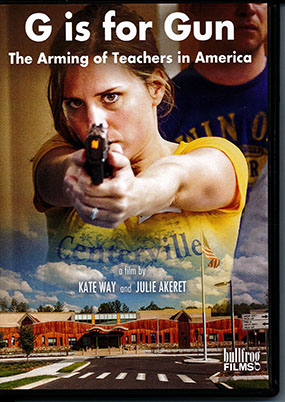
G Is for Gun: The Arming of Teachers in America 2017
Distributed by Bullfrog Films, PO Box 149, Oley, PA 19547; 800-543-FROG (3764)
Produced by Kate Way and Julie Akeret
Directed by Kate Way and Julie Akeret
DVD, color, 27 min.
High School - General Adult
Gun Control, Education, Teachers, School Violence, School Shootings
Date Entered: 01/08/2019
Reviewed by Wendy Highby, University of Northern ColoradoActive shooter training exercises have become standard procedure for school employees in the United States over the past two decades, as school shooting incidents occur more frequently and grow increasingly lethal. But how many educators carry firearms at work and have trained to become armed members of a team of first responders? G Is for Gun opens and closes with a surprising statistic: as of the documentary’s 2017 release date, at least thirteen states sanction the arming of school employees so they may function as the first line of defense against school shooters. The film zeroes in on Sidney, Ohio. High School Principal Jon Geuy describes the town of 21,000 as an “inner city surrounded by cornfields.” In 2013, Sidney City School District became one of the first in the nation to arm teachers and the Shelby County Sheriff’s Office began training them to act as armed first responders. District Superintendent John Scheu demonstrates the fingerprint-recognition security on biometric safes that hold the educators’ Glock 23 handguns and he displays their bulletproof vests. He explains the pro-arming policy’s genesis as a direct reaction to the level of carnage at Sandy Hook Elementary School in Newtown, Connecticut in 2012.
Documentarians Kate Way and Julie Akeret present a carefully-crafted, seemingly symmetrical narrative that concisely allows the pro- and anti-arming perspectives to play out; the biases of each are revealed in sharp relief. A pro-arming 7th grade social studies teacher/coach explains that he will be an armed first responder because he cannot “sit back and let the government do everything.” An anti-arming teacher comments that educators already shoulder too many responsibilities and another expresses regret that the school’s climate is becoming more penal and militaristic because of the policy changes. Ingeniously edited, a sophisticated storyline threads through the film as academics offer their expertise in between the protagonists’ statements. In an early scene, teacher Amy Baldauf defines the term “narrative” for her first graders. Instructed by proxy, viewers are subconsciously primed to take note of each side’s rhetorical tilt. Thus the audience is bequeathed the power to evaluate the talking heads and encouraged to be conscious of the framing of the pro and con stories.
The interwoven expert commentary considers the psychological and sociological context, offering long-term systemic solutions that tend to align with the anti-arming side. OSU Professor of Educational Studies Bryan Warnick argues that the first responder teacher training is a quick and cheap fix. Kenneth Saltman, Professor of Educational Leadership, at the University of Massachusetts-Dartmouth, contends communication is key, a better alternative than the escalation of force proposed by the frame that we must accept violent solutions to our social problems. Social scientist Katherine Newman, the author of Rampage: The Social Roots of School Shootings (2008), recommends making it easier for children to report suspicious or troubled behavior of peers—they are an early warning system. These academics tout trust, communication, and nurturing relationships, emphasizing that smaller teacher to student ratios will result in safer, healthier, and more connected communities.
Countering the professorial commentators and anti-arming faction is Jim Irvine, President of Buckeye Firearms Association; he cites burgeoning community interest in and support for firearm and first responder training of teachers as justification for the current policy. But the Sidney Police Chief William Balling disagrees with the arming of teachers, believing that more civilians with firearms would increase the danger. Scott Jackson of the Sandy Hook Advisory Commission provides a model of a community that contrasts with Sidney, noting the Newtown Commission’s unanimous decision not to arm their teachers.
Remarkably, G Is for Gun manages to avoid the rigid stalemates typically encountered in reductionist gun control argumentation. Instead of the inevitability of escalated violence, it proposes a resilient, non-violent community-building response. It also supports the democratic traditions of our public education system, exposing the disturbing trends toward lack of transparency (decisions made in closed executive sessions and a lack of requirements to inform parents and local law enforcement of districts’ firearms policies). The film is highly recommended for high school level and above. It would be a fine tool for community and civic groups as well as classroom teachers. A showing of the half-hour film could be a precursor to thoughtful discussion, and may inspire participatory policy-making processes in communities seeking effective solutions. G Is for Gun: the Arming of Teachers in America is a disarming film that provides a catalyst for critical thinking, democratic policy creation, and decision-making with the potential to increase the well-being of schools and communities.